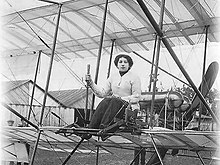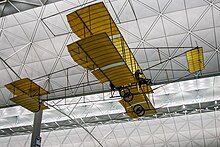Lidija Sverva
Lidija Wissarionowna Zvereva ( Russian Лидия Виссарионовна Зверева * 1890 in St. Petersburg , † May 2. . Jul / 15. May 1916 greg. In Petrograd ) was a Russian aviation pioneer , entrepreneur and the first female pilot in Russia Empire.
Life
Lidija Vissarionovna was born in Saint Petersburg in 1890. Her father Vissarion Lebedew was a general who had earned services in the Russo-Ottoman War (1877-1878) . After the usual education of higher daughters, she married the engineer I. S. Swerew at the age of 17, but he died after two years of marriage.

In June 1911, Swereva began flight training in Gatchina . She paid 400 rubles for lessons and 600 rubles bail for damage to the plane. Your flight instructor Vladimir Viktorovich Sljusarenko (Владимир Викторович Слюсаренко, * 1888) was just about to finish his training with the pilot's license number 23 . A month later she was copilot and navigator when he tried to fly with other pilots from Saint Petersburg to Moscow . The attempt ended with engine failure. At the next take-off, another pilot took second place because he had provided the replacement engine. This engine also went on strike, the copilot died during the emergency landing and Slyusarenko had to be hospitalized for a long time. A single machine reached the Khodynka field northwest of Moscow city center.
On August 10, 1911, Zvereva was the first woman in Russia to receive a pilot's license, which bore the number 31 . Instead of the required two, she had flown five “eights” and hit the landing field exactly after the approach with the engine switched off. In the following year she went on demonstration flights in Baku and Transcaucasia with Slyuzarenko, whom she married in 1913 . In Tbilisi , their plane was destroyed by a storm before the air show and they had to sell the engine to compensate the owner of the racecourse for the loss of income.
One year later, in April 1913, the Sljusarenko couple founded a workshop for building and repairing aircraft and a flight school in which they trained young pilots in Sassenhof near Riga , the center of Russian aviation at the time. The engine manufacturer Fyodor Kalep provided support. In October the first two Farman XVI were delivered to the military. They were significantly improved versions of the French reconnaissance aircraft . By the summer of 1914, eight more machines had been assembled.
At the beginning of the First World War , the company was relocated to Petrograd with military subsidies . In two years the company produced 15 Farman XXII , 25 Morane Parasol and eight Farman IV biplanes for the Russian air force, which were in great demand for training purposes. Several Morane Gs with a span of 14 meters were also built . Swerewa was, among other things, the company's test pilot , who flew in new machines and checked design changes. In 1916 the company had 460 employees and by the end of the war had completed 20 Lebedev-12s , 28 Morane G (14 m), 45 Morane G (16 m), 20 Farman IV and 4 Farman XVI.
Lidija Vissarionovna Swereva died of typhus on May 2, 1916 in her hometown of Petrograd at the age of 26 . Airplanes circled over the facility during the funeral in the Nikolaus-Friedhof .
The aircraft factory produced beyond the October Revolution of 1917. Swerewa's husband, who married a second time, emigrated to Australia via Harbin , where he died in 1969.
Aviation
After completing the exam, in 1911, Zvereva replied to the newspaper reporter "Петербургского листка" (Petersburg Gazette) when asked about their future plans: to open the way for Russian women to aviation. I invite you to follow me to complete victory over the air.
Swerewa is considered to be the first female aerobatic pilot. In May 1914, at a demonstration in Riga, it showed a dive with the engine switched off, which was followed by a loop after restarting . In addition to the " Nesterow looping", she also mastered the "Arzeulow corkscrew". Although she had severe accidents a few times, she got away with abrasions and bruises. In competitions it happened that competitors manipulated Swereva's engine with iron filings. She was also technically gifted and was able to repair minor damage to the aircraft herself.
Konstantin Arzeulow later said: Zvereva flew boldly and resolutely, I remember how everyone paid attention to her masterful flights, including the soaring flights. At that time, however, not everyone risked reaching great heights.
Honors
In honor of Sverva, a street at the former airfield in Gatchina was named after her.
The Venus crater Zvereva (45.3 °, 283.1 °) with a diameter of 22.3 kilometers also bears her name.
See also
- Yevgenia Michailovna Schachowskaja (1889–1920), first female military aviator in history.
literature
- Eileen Lebow: The Imperial Eagle Sprouts New Wings. In: Before Amelia. Women Pilots in the Early Days of Aviation. Potomac Books, 2002. pp. 90-91.
Web links
- Александр Пронин: "РУССКАЯ АВИАТРИССА". (Russian)
- «Первые Женщины-Авиатриссы в Царской России." (Russian)
Individual evidence
- ↑ Vladimir Victorovich Slusarenko and Lidia Vissarionovna Zvereva . (English, accessed April 19, 2019)
- ^ The Imperial Eagle Sprouts New Wings. P. 90f.
- ^ Lunar and Planetary Institute : Zvereva in the Venus Crater Database. (English, accessed April 19, 2019)
| personal data | |
|---|---|
| SURNAME | Sverva, Lidija |
| ALTERNATIVE NAMES | Зверева, Лидия Виссарионовна (Russian); Lebedew, Lidija Wissarionowna (birth name); Sljusarenka, Lidija Vissarionowna (married name) |
| BRIEF DESCRIPTION | Russian aviation pioneer |
| DATE OF BIRTH | 1890 |
| PLACE OF BIRTH | Saint Petersburg , Russian Empire |
| DATE OF DEATH | May 15, 1916 |
| Place of death | Petrograd |

